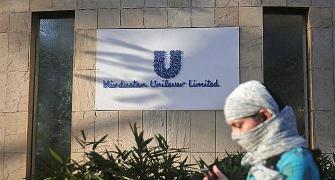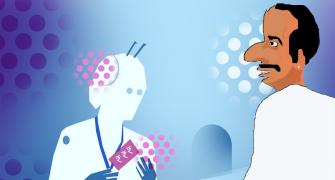
For a decade now, American computer hardware and software major International Business Machines has been supporting Linux or the open source movement.
In 2002, Linux, the source code for which is freely available to anyone, became the key operating system for IBM servers. But what began as a move to rupture Microsoft's monopoly has become a passion of sorts for IBM.
In January, it opened up to other companies its intellectual property business with over 40,000 patents. In other words, it offers a patent licence to users of any software programme whose source code is made available for use or modification.
And promoting it with an evangelical zeal is Jim Stalling, vice president, IP and Standards at IBM. For him, the key growth drivers for Linux in India are its business partners, who can avail of the open source software to become globally competitive. He speaks to Nandini Lakshman, about arch rival Microsoft and why IBM has become magnanimous with its patents.
Why has IBM opened up its patents for open source or free software?
Because there's a movement underway where customers want to deploy open source software and solutions. This is a global movement and it's also happening with India.
We have responsibilities to our customers, so we decided to embrace open source and open standards and use it and build our solutions so that they takes advantage of open source. It's a combination of what we do on the proprietary side and what we do on open source.
We decided that we also should inspire open standards to accelerate even more. And the best way to do that is to contribute some of our IP to open source projects.
That's why we made a pledge back in January to pledge our patents to help make that happen. We brought our IP business with over 40,000 patents with $1.2 bn of licensing income and open source and open standards businesses together, so that they can fuel each other and we can leverage both.
The combination of insights in both will help us create more things faster. It is not only important but exciting. All this talk of open source software and standards is not being driven by technologists but by customers.
Many in the industry feel that when companies refer to IP, it is mere propaganda. Isn't it?
No. First of all customers need reliable vendors. They need technology that's original and solves problems. And customers are willing to pay vendors for reliable, advanced technology and solutions.
That's intellectual property. Customers recognise that companies that create this warrant some form of compensation or recognition. That's what IP is, it's value for an invention. If there is no value for invention, then why invent?
Technology advances because there's value in it. And it advances rapidly because there are increasingly more places to deploy technology to solve customer problems. We have been at this for the past 50 years.
IBM has been a market leader for inventions and patents for the past 12 years in the United States. It's incredible that ours and other companies' technology creates value, and that value is worth a lot to our company, customers and shareholders.
We have to continue to do that, so we continue to invent. We can expand the areas that we can deploy our inventions. And it's not only a value to us, but it is a value to the companies we license these patents to. It could be smaller start-up companies that want IP as part of their solutions. This creates economic opportunity.
How are you getting your business partners excited about this?
We have an expanding ecosystem around what we do with our proprietary IP.
There is also a very large channel and ecosystem around open source. That is part of the patent play. We see both of these working together. The primary flaw here is that no one company can create the most important innovations in information technology.
This is advancing too fast and companies are using and deploying IT in so many different ways. It used to be primarily for data centres.
Now it's across everything they do. They use technology to reach out to their customers all over the world.
To do that, you need lots of channel partners, lots of people participating, developing designs and putting them together as a solution to customers.
So the open source, open standards and proprietary IP -- they all work together. It's an innovation network of partners that come together to create something new, because some of the challenges for customers are really big and tough and no one company can solve it.
Given some of the healthcare problems and some of the issues with hunger and food, it's not going to get solved by a company, but by lots of companies that work together.
Our vision has always been to broaden the opportunity for lots of people and broaden the opportunity to solve the problem.
What sectors are you looking at?
We are looking at all sectors around the world in all the segments. We have IP in all areas. Our primary discussion in India is around the standard of radio frequency identification.
It applies primarily to manufacturing, distribution and retail, but you can also take that technology to other communications like banking and other sectors.
How do you plan to penetrate these sectors?
The basic strategy is to help small companies, emerging, high growth companies that may want to become part of a channel to large distributors and large manufacturers and become part of their network.
We want to create a solution for small, emerging, high growth companies to enter the market, help them identify opportunities, so that large retailers can gain access to their products.
This strategy is India specific. In India, the opportunities are for the small and emerging companies and we are targetting them.
Now Microsoft is also showing its Windows source code to governments. What are the implications of this?
Microsoft allows select individuals and governments to look at the source code. That's different from open source where you don't need a licence to see it or modify it according to your environment. And as you improve it, you can shift the modifications to anybody else in the world.
The Windows source code programme, as I understand it, is that you can see it but not tell anybody. If you modify it, you have to give that modification to Microsoft. So shared source and open source are two radically different ideas.
The largest sector that deploys Linux is the government sector, not only in a high security environment but also where there is e-governance deployment. As they take all of these services online, they use Linux as a way to take it online.
A lot of customers continue to be loyal to Microsoft software. How do you plan to make them switch loyalties?
It is not a matter of switching loyalties. We work with business partners to enable them to do both. We are simply saying that you do both because your opportunities as business partners double or treble if you have multiple offerings.
So we say, choice and flexibility is good for a business company. But if you limit yourself, you limit the opportunities.
Today, Microsoft is also coming out with cheaper software. How will this affect you?
It is good. Microsoft is reducing prices because Linux is more competitive. One of the things that customers understand is that when there is choice, they benefit because competition drives prices to a competitive level. When there is a single monopolistic solution, customers don't benefit with lower prices.
It isn't just Linux, but other open source solutions that are driving prices down. Microsoft is simply reacting to the market.
How much of IBM's move to bring its patents on the open source platform, is done from the goodness of its heart? Or is it a crusade to destroy Microsoft?
No. We've been in inventions for patenting for 50 years. We've also been involved in the open source movement for a decade. What's new is combining them for innovation.
We see a world where there's going to be a lot of technology innovation. So we say that we are going to work with others to invent some of that.
Customers are going to deploy integrated solutions and not holistic things. It is very heterogeneous. So we said that we can embrace all of it.
If there is one thing that I have learned, it is that customers want to have multiple choices, multiple providers and best of breed solutions in their environment.
No one company is going to have all the answers. For us to get our share of the opportunity, we've got to work with others with our inventions and work with the open source community.
The proof is in what's happening in the marketplace. We see that there is more demand for our technology than ever before, but there is also more demand for open solutions than ever before, particularly in the government sector.
They don't want to be locked into a single company. If that happens, if they want to upgrade or change, they won't be able to move flexibly. The only way to do it is with open source.







